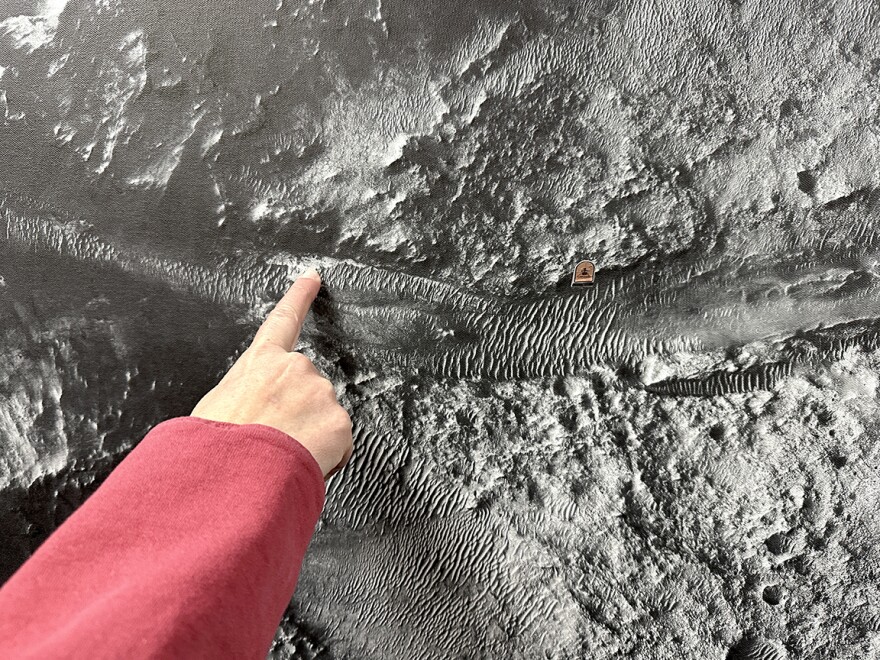During the past year, place names from the Grand Canyon have turned up on the surface of Mars. To find out why, author Scott Thybony sought out scientists from the Astrogeology Science Center in Flagstaff who’d been exploring the Martian surface.
Robotic vehicles have been exploring the surface of Mars for years. The video images sent back have become for me a long meditation on rock and sand. I find myself spending more and more time watching them, drawn into the wind-scarred expanses of a distant planet. And in the summer of 2024 NASA announced the discovery of an intriguing rock. It contained possible biosignatures, including organic compounds and distinct spots caused by chemical reactions often associated with life.
The Mars rover Perseverance had entered a region known as Bright Angel, and for some reason they called the rock, “Cheyava Falls.” What were these Grand Canyon names doing on Mars, I wondered? Taking a closer look at the maps, I found the rover also passed a Separation Rapids, a Cedar Ridge, and a Dox Castle. All of these places were familiar to me from time spent in the Grand Canyon.
Curious about the names, I arrange to talk with two scientists who have been actively exploring the surface of Mars from their basements in Flagstaff. The idea intrigues me. Ryan Anderson and Alicia Vaughan meet me at the USGS Astrogeology Science Center, and soon I’m listening to their firsthand accounts. They range from the exhilaration of successful landings to the frustration of working for months to extricate a rover stuck in the sand.

Then I bring up the discovery of what might turn out to be the first evidence of ancient microbial life beyond our planet. But both scientists caution me that it’s premature to claim the team has found life on Mars. The possible biosignatures may be evidence of life, but they could instead be the result of geological processes completely unrelated to life. Until a core sample can be returned to Earth for analysis, scientists won’t know for sure.
Ryan goes on to explain the origin of the Grand Canyon names. “The landing site,” he says, “is divided into quads, just like we do on Earth for mapping purposes. Each one of those quads is named after a national park somewhere in the world. Once we’re on the surface in that quadrangle, all of our target names are places from within that park.”
As the conversation continues, Alicia describes how Earth and Mars started out so similar but ended up so different. “You can look at Mars and see Northern Arizona,” she says. “You can look at these stacks of rocks and you’re like, ‘Wow, that looks like Sedona.’ They’re so, so similar but missing all the vegetation. That’s just fascinating.”

Ryan has been exploring Mars since grad school, and Alicia has been studying the planet for her entire professional life with the exception of a long break to teach school. “I identify all the time as a Martian,” she says with a laugh. “I write emails to my colleagues and begin with, ‘Hello Martians.’”
In their years spent investigating the surface of another planet they have become deeply familiar with the terrain of Mars. Ryan mapped the Curiosity rover’s landing site at Gale Crater before it was selected. And both spent weeks at the Jet Propulsion Laboratory in California immersed in the stark Martian landscapes they studied from orbit.
“The first time I came back home,” he recalls, “it was late summer in Flagstaff with all the wildflowers. I went out to walk the dog in the morning and everything was covered in dew. I’m like, ‘Wow, this is a really nice planet.’ It’s such a contrast to this really, really barren place. It’s . . . covered in life and covered in water everywhere.’”
Sometimes it takes exploring a planet 140-million miles away to fully realize the beauty of the home planet.
Scott Thybony is a Flagstaff-based writer. His Canyon Commentaries are produced by KNAU Arizona Public Radio.



